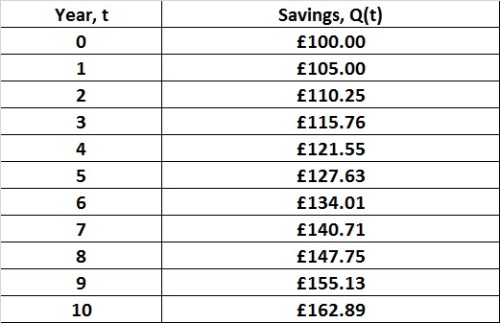In his best-selling book A Brief History of Time, Stephen Hawking wrote:
Someone told me that each equation I included in the book would halve the sales. I therefore resolved not to have any equations at all. In the end, however, I did put in one equation, Einstein‘s famous equation, E = mc². I hope that this will not scare off half of my potential readers.
Since I’m the only one who ever reads this blog, and I can’t scare off half of myself, I’m going to plough right in and put an equation into this post.
It is an equation that the lecturer has talked about a few times in the Calculus course:
.
Now that may not mean much to you, but it is saying that if we start off with some number Q0, which grows by n% a year; then after t years, it will grow to Q(t)*.
This equation could represent the money we put into a bank account that pays interest each year. For example, if I put in £100, and then get paid 5% interest each year**, then Q0 becomes 100 and n becomes 5:
Now our equation is simple to interpret***. If we want to know how much money will be in our account in 1 year’s time****, Q(1), we put t = 1 into our equation and see what pops out. Putting t = 2 will tell us how much will be there in 2 years time, Q(2). We can then put t = 3 for 3 years, t = 4 for 4 years etc.
Rather than work it out by hand for each year, one can put the equation into spreadsheet software, like Microsoft Excel, and work out how much we will have in our account so many years from now:
So in just 10 years, our £100 has become almost £163 – just under two-thirds as much again. This is the miracle of compound interest and why it pays to have savings or other financial assets to make money for you. No more by the sweat of your brow will you eat, but by the sweat of others.
.
*I have heard it said that seeing letters in maths hopelessly confuses people. Isn’t maths about numbers, not letters? Well, here the letters stand for numbers. n could be 1%, 2% or 33.3%. t could be 2 years, 5 years, or threescore years and ten.
Maths is a far more logical and simple language than our spoken languages, and in many ways more useful. However, we pick up our mother tongue when we are very young and absorb so much. We don’t, unfortunately, pick up algebra until we hit secondary school, when learning becomes more of an effort.
**One day we’ll tell our disbelieving grandchildren that savings accounts once did pay 5% a year.
***Powers or Exponents and Exponential Growth: OK, maybe not entirely simple to interpret. I suspect you may be happy with adding, and even the fraction 5/100. But what about that t floating to the top right of the brackets. t is a power or exponent. It means we multiply whatever is in the bracket by itself t times.
(1 + 5/100) = 1.05
1.05² = 1.05 × 1.05 … 1.05 is multiplied together 2 times
1.05³ = 1.05 × 1.05 × 1.05 … 1.05 is multiplied together 3 times
1.05t = 1.05 × 1.05 × 1.05 × … × 1.05 … 1.05 is multiplied together t times
Because of the exponent, this equation is an example of exponential growth, which would also describe the growth of human populations, or economies, if we didn’t put such a bunch of dangerous clowns in charge.
***This assumes we don’t deposit any more money. We are just accumulating interest on the initial deposit.




Pingback: The Wheat and the Chessboard | Steven Clarke's Blog
Pingback: Exponential Economic Growth | Steven Clarke's Blog